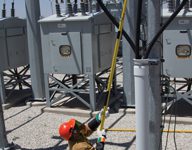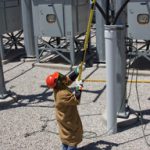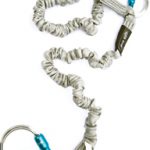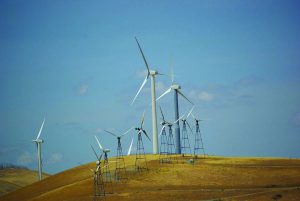Part of the daily routine of working on wind turbines is completing a job safety analysis or job hazard analysis (JSA or JHA). No matter what your company calls it, this anyalyis is a necessity. Part of the JSA should be a discussion on rescue planning, whether it is from the basement, nacelle, hub, top of nacelle, ladder, etc.
M any times we are aware that a general site rescue plan exists, but can be unsure if current staffing and eqipment resources allow for successful implementation. If you are part of supervisory or managerial team, you had better be sure! Relying on the local fire department to do the rescue is not a good idea since most wind farms are rural and 99 percent of all rural departments have little to no technical rope rescue training. Even if they did, a wind turbine and its components would more than likely be as foreign to them as trying to do a rescue from the space shuttle booster rockets. What’s more, the response time is an issue. A big city fire department may have a greater level of training, but again, wind turbine rescue is usually not part of the training regimen. Twin energy absorbing lanyards and the vertical fall arrestors you see on the ladders is not something for which I would expect a fire department high angle team to be trained.
any times we are aware that a general site rescue plan exists, but can be unsure if current staffing and eqipment resources allow for successful implementation. If you are part of supervisory or managerial team, you had better be sure! Relying on the local fire department to do the rescue is not a good idea since most wind farms are rural and 99 percent of all rural departments have little to no technical rope rescue training. Even if they did, a wind turbine and its components would more than likely be as foreign to them as trying to do a rescue from the space shuttle booster rockets. What’s more, the response time is an issue. A big city fire department may have a greater level of training, but again, wind turbine rescue is usually not part of the training regimen. Twin energy absorbing lanyards and the vertical fall arrestors you see on the ladders is not something for which I would expect a fire department high angle team to be trained.
Most state and provincial regulations require that if using fall arrest as a means of fall protection, your company must have a rescue plan. This can involve using your staff or contracting with a specialized rescue team. Even if the regulations don’t plainly state this in your jurisdiction, you still need to protect the worker, as that is the intent of all safety regulations. Remember, you have supplied your worker with fall protection equipment that will stop them from falling to their death; but once they are suspended, you have introduced them to a new danger—suspension trauma. Keep in mind that even if they are not hanging (unconscious on top the nacelle, for example), you would need a rescue plan that would get your patient to the ground no matter the situation. In the event of an injury, there is a high likelyhood you will have to go to court.  Defending claims in those circumstances requires that you prove due diligence in preventing the injuries. Considering your awareness of the suspension trauma issue and the fire department issue, preparedness is essential.
Defending claims in those circumstances requires that you prove due diligence in preventing the injuries. Considering your awareness of the suspension trauma issue and the fire department issue, preparedness is essential.
What follows is a framework for designing and implementing a JSA, and centers around three components:—work methods, equipment, and training.
Work Methods
Have the fall protection methods (i.e. travel restraint, work positioning, self-retracting lifeline/ energy absorbing lanyard) been evaluated recently for the different types of work and locations? Maybe the turbines have had physical modifications, such as hatches, decks, guardrails, man lifts, anchor locations, etc., that need to be taken into account. Get as much feedback from the field technicians as possible. You should also ask them for possible solutions. They are up there working every day, whereas it is sometimes difficult for the safety person to devise an effective solution without actually doing the specific jobs routinely.
Equipment
Considering the recent influx of new safety equipment technologies in the marketplace, it is crucial to investigate what is out there. Too often, we hear workers say they are using a piece of fall arrest equipment that will still allow them to hit the ground in many situations. They continue to use this equipment either because they are instructed to do so per a work procedure, or because no one has come up with a solution. There is always a solution, because the alternative is a fall injury. Most labor enforcement agencies have zero tolerance policies regarding fall incidents, so we must find a solution.
Rescue equipment also needs to be evaluated regularly. This often requires more than one type of device and technique. Don’t be afraid to look around and see the capabilities of other devices. Alternately, make sure you keep up to date with what you manufacturer will allow you to do with your rescue device, as this often changes. Sometimes the manufacturer allows equipment to be used in different ways, while other times they will impart new restrictions.
Training
Technical rope rescue gear that a high angle rescue team uses will work, but is often complicated and requires constant training. This is not a good idea if you don’t train monthly.
 Choosing pre-rigged rescue equipment that is simple to use is key. Most manufacturers have something like this on the market, but we sometimes see way more complicated systems put into place. This is often due to decision-makers’ acceptance of the status quo and failing to innovate. The person in charge is often convinced the complicated way the only way,as that is all they know or have been taught.
Choosing pre-rigged rescue equipment that is simple to use is key. Most manufacturers have something like this on the market, but we sometimes see way more complicated systems put into place. This is often due to decision-makers’ acceptance of the status quo and failing to innovate. The person in charge is often convinced the complicated way the only way,as that is all they know or have been taught.
When your staff takes its fall protection and rescue training, they need to know the capabilities of their rescue equipment and PPE (along with any limitations your company or manufacturer may impose). Conducting hands-on drills should include moving bodies (dead weight) around obstructions to give the participants a greater appreciation of what is physically possible. This will of course make for better rescue plans.
I always like people to be able to visualize the rescue realistically. What I mean by realistically is that they have taken into account the limitations of the equipment, staff and have addressed as many of the variables as they can.
The Resuce Has To Be Executable For example, the rescue plan may state the rescuer will move the patient over an obstruction. That may work most of the time, but what if today the patient outweighs the rescuer by 100 pounds? Was that taken into account when preparing the rescue plan?
For example, the rescue plan may state the rescuer will move the patient over an obstruction. That may work most of the time, but what if today the patient outweighs the rescuer by 100 pounds? Was that taken into account when preparing the rescue plan?
So in a nutshell: assess your work locations and methods of fall protection regularly so that you are doing the work as safely as possible; choose easy-to-use and easy-to-remember rescue equipment, since the main job of your personnel is not that of a professional rescuer; and train your staff to use your gear effectively and prepare realistic rescue plans so they can actually execute them when needed.
| (905) 827-0007 | www.team1academy.com/ |



































